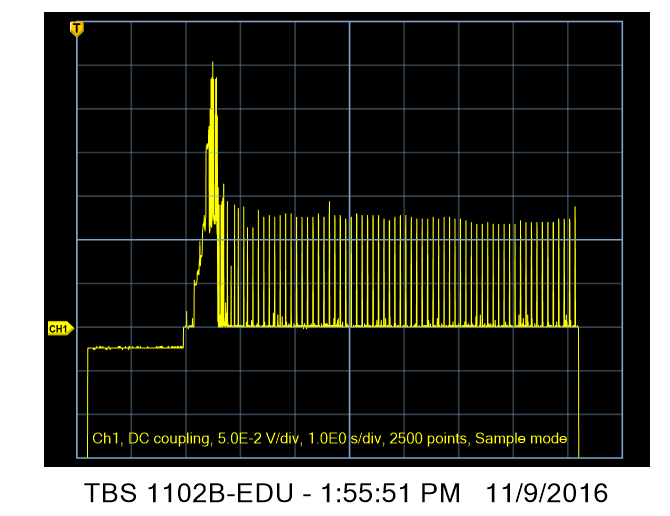This is a continuation in a series of posts on power consumption in the Sony a7RII. The more recent incarnation of the series starts here.
A reader asked me to look into the a7RII battery current with a USB charger attached.
Here’s the startup cycle under those conditions with a close-to-fully charged batter attached:
The vertical axis is about 200 milliamps per division. The timebase is 1 second per division. I have moved the zero-current vertical position higher on the screen, to a point marked by the icon labeled CH1 on the left. The camera is turned on at about the second division marker. You can see that the current is negative before the camera is turned on, which means that the camera battery is being charged. The charging current is about 100 ma.
Once the camera has settled down into operating mode, the bottom of the jagged current waveform (jagged because of the periodic readout of the sensor and refresh of the LCD display — is approximately zero. That means that most — but not all — of the camera’s current demands are being supplied by the USB power source (I used a wall wart with isolated outputs).
You will note that the difference between the camera-off and camera-on currents as smaller than when the camera is running entirely off the battery, indicating that the camera is drawing more current from the USB port when the camera is on than when it’s off. That might be difference with a nearly-exhausted battery.
If things continued indefinitely like this, the camera would eventually discharge the battery. I suspect that, after the battery discharges to a certain point, the camera will start to draw more current from the USB port. I’ve never used the camera when it’s powered through the USB port, so I don’t really know, but it would seem a poor design if it couldn’t substitute for an external source that plugs into the battery compartment.

Thank you! This is great. The only thing to make this better would be if Sony used a USB-C port. I always worry about breaking the micro USB ports after a lot of use.
Well, a billion years later I found your excellent post and can confirm that the battery does, indeed eventually exhaust itself even when plugged in to USB power. I am trying to come up with another method to power the camera for full-time always-on use. So far without luck.